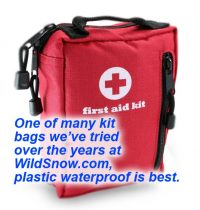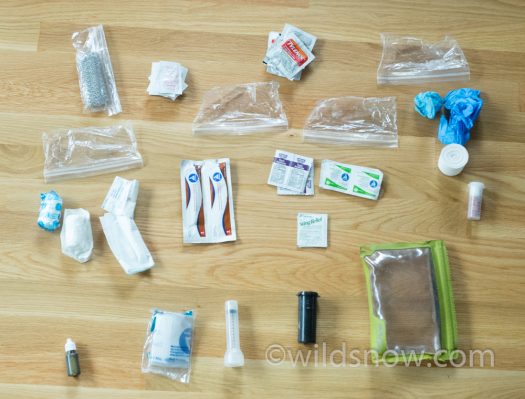I’m conflicted. I’m a fan of carrying a fairly comprehensive first aid kit. But I’ve never used the majority of items. Ibuprofen and tape are the only things that have seen use more than once or twice in my entire life as a ski mountaineer. Yet someday everything will come in handy, and I’m sure I’ll be grateful I lugged it. But can I lug less?
My compact repair-first-aid bag sits in the bottom of my pack on almost every ski tour and gets beat up. I took the whole thing apart, reevaluated the need for each item, and renewed anything necessary. Turns out a lot needed replacing. Most of the pills had been damaged by water, my alcohol swabs were completely dried out, and my roll of tape was gooey and useless.
I carry as minimal a first aid kit as possible. (For a beautifully designed kit that’s of the more complete nature, check out our Denali version from 2010). I like constructing it from scratch rather than buying a pre-built. For one thing, doing so is significantly cheaper. Also, just as writing notes helps internalize info, packing the kit piece by piece means you know exactly what is in there, and (hopefully) how to use each item.
Since I build it myself, my kit is significantly different than most off-the-shelf kits. Weight is reduced by eliminating unnecessary items, and I include a few things that are typically found only in large multi-day kits. The main thing I cut out is band-aids. Most kits are stuffed with them, and they take up a lot of space. Perhaps first aid kit companies include wads of band-aids because they’re a cheap way to make their kits bigger. Who knows. Regardless, a roll of tape and some gauze can be used for anything you might need a band-aid for, and have tons of other uses.
Let’s begin with the foundational item. Whatever you do, carry your first-aid items in a 100% waterproof bag (consider tossing in a few desiccant packs to cut condensation), and package water sensitive items in small ziplocks so when you empty out your kit during a stormy incident, you don’t end up soaking everything. Here at Wildsnow we’re big fans of the beefy UV resistant transparent cases sold to protect things such as phones (test in freezer for low temp durability). We’ve had good results from the E-case or SealLine cases. SealLine E-Series Case (18, Green)
On this round of updating I added a few items to my kit. For one, I didn’t have a CPR mask in my kit for some reason. CPR is at the top of first aid skills (along with controlling bleeding and cervical stabilization), in terms of really saving a person’s life. The breathing part of CPR is definitely doable without a mask, but can be unsafe for the rescuer, particularly if the patient vomits, or is bleeding. I, for one, hope to live my entire life without someone puking into my mouth. Even if you disregard the increased safety, I’ll certainly be less hesitant about giving a stranger mouth to mouth if I have a mask. They are hard to find in a store. This time, found some online, and bought a few.
Another new item is a wire mesh splint. I’ve avoided carrying a SAM Splint, since they are bulky, and only have one function. Granted, they perform that function very well. After hearing stories about how difficult and painful it is to use an improvised splint, I started thinking about alternatives. A friend showed me wire mesh splints, which are essentially a SAM splint without all the bulky foam. Packs tiny, and functions the same as a SAM splint. A sock or gauze or something similarly soft can be wrapped around the bare wire to make it more comfortable for the wearer.
I also removed a few items from the kit. I took out elastic bandages, as they seem bulky and not very useful. I also used to carry high-power prescription pain meds. However, after research, it seems like the potential complications that could arise aren’t worth it. I go back and forth on that one, though. Your comments, dear readers?
In the past I have carried some repair kit items in my first aid kit as well. However, I often found myself using the same first aid kit for trips that didn’t necessarily need any repair kit items (hiking, climbing, etc). Now my first aid kit only has first aid items, and I have a separate repair kit, that I only take on ski trips.

My updated first aid kit, with all the items stored in small ziploc bags. The bag that holds the kit is visible in the lower right as well.
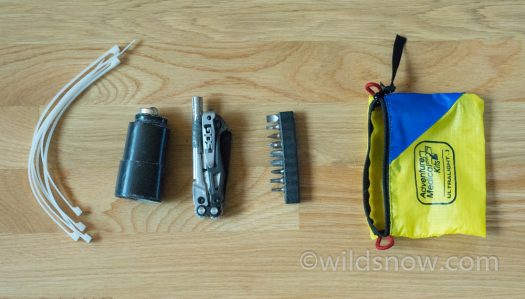
My tiny repair kit. I rarely have ever needed more than this when making repairing ski gear. (Not pictured: a small coil of bailing wire). It could be wise to carry these items in a waterproof container as well, or at least in a ziplock inside the nylon bag. Otherwise, the screwdriver bits will rust, and the lighter could be compromised. It’s also a good idea to have a bit of redundancy with your fire source; perhaps carry two lighters or simply be sure other group members have fire starting items as well.
Here’s a list of what I currently have in my first aid kit.
Medications (variety important for different needs, per first aid training):
- Ibuprofin: By far the most used item of my kit. I pull out my little bottle of Vitamin I several times every season, for knee pain, headaches, etc. It’s much more convenient to carry them in a little easily refillable bottle, rather than the fiddly packets that most first aid kits are supplied with.
- Tylenol
- Aspirin
- Diphen (or Benadryl)
Wound care:
- Tape: Perhaps the second most used item in the kit. I carry a fairly large roll; running out of the stuff is a bummer.
- 4″ gauze roll: for everything from bloody noses to gaping wounds. I’ve found the rolls to be a bit more space efficient than the sealed gauze pads.
- Iodine swabs: A fairly bulky item, but handy for cleaning out wounds.
- Betadyne dropper bottle: I bought a bunch of tiny dropper bottles off Amazon, and filled some with Betadyne. Good for all types of disinfecting.
- 60 cc Irrigation Syringe Easily the bulkiest single-function item in the kit. I go back and forth on whether it is useful enough to justify the space it takes.
- Neosporin packets
Miscellaneous:
- Gloves I have two pairs of medical gloves in my kit.
- Bleach: I filled another of the tiny dropper bottles with bleach. Used to disinfect water. Not exactly a first aid item, but an important item nonetheless.
- Primacare IS-5526 Wire Mesh Splint, 26″ Length x 4″ Width Cheap, compact, and useful.
- Bug bite relief swabs: very light and small, and can really help a hornet sting.
- Matches and firestarter: I keep a small firestarting kit in a film canister (anyone remember those?) Not exactly a first aid item, but an important emergency item.
Here’s what I have in my repair kit:
- Zip ties
- Gorilla tape, wrapped around a bic lighter
- A small coil of bailing wire.
- SOG Multi-Tool: modified to accept standard screwdriver bits.
- Screwdriver bits: selected sizes and types that cover most ski binding uses, while still staying fairly minimal.
Anything I missed? I’d love to hear from some more medically experienced types what are some must-have items in in a minimal first aid kit. One heavily questioned item is the EpiPen. Should every kit have one, or at least one per group? Also important: If you tend to ski with the same partners, coordinate emergency and first-aid gear. For example, one of you could carry the wire splint while the other could haul the wound care items. At the least, ask within your group so you know what your resources are. You could do this during the beacon check, or when you’re setting up the 2-way radios.
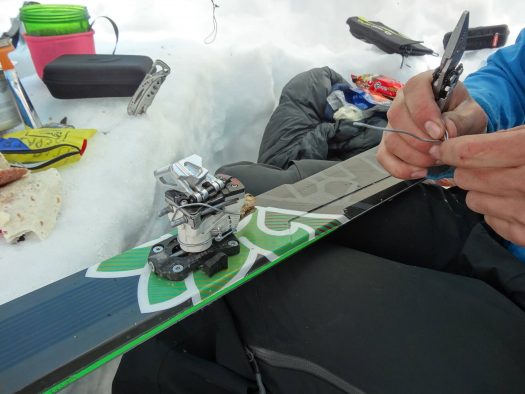
Bonus pic: Dynafit heel repaired with nothing but bailing wire and a stick (and lots of head-scratching).
Check out our other first aid kit links.
(Please know this blog post contains affiliate sales links. Thanks for shopping our links and helping support our work here at Wildsnow!)
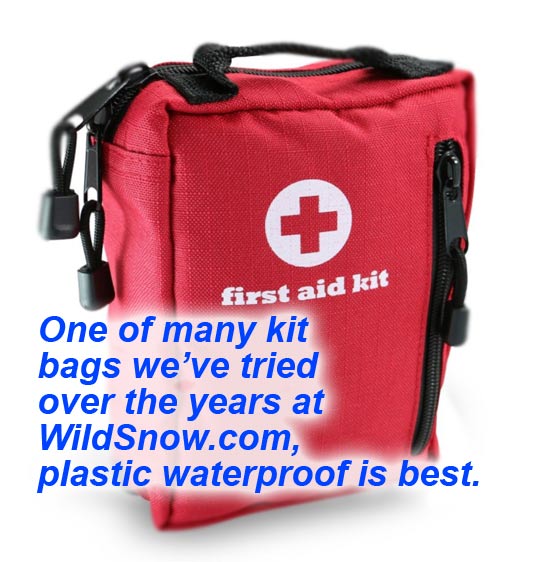
Example of first aid kit bag, not waterproof so contents would need to be heavily protected.
Louie Dawson earned his Bachelor Degree in Industrial Design from Western Washington University in 2014. When he’s not skiing Mount Baker or somewhere equally as snowy, he’s thinking about new products to make ski mountaineering more fun and safe.

